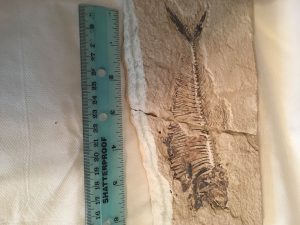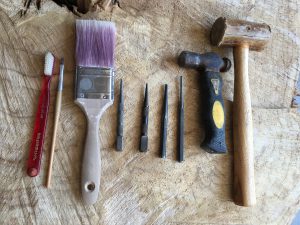The fossils we collectors gather have been buried in the rock for hundreds of thousands of years to millennia.
When we’re lucky to find one, it’s invariably been exposed for a short time, and we’re not speaking of geological time we’re speaking of months or years.

So we collect them and thereby become stewards of the past. With that stewardship comes the responsibility of fossil preservation for each specimen. If the fossil is of softer material, care must be taken to prevent damage when preserving.
Fossil Preparation
The first item of business would be to collect a tool kit.
You will need:
-
- a small hammer,
- a few different sized pointed chisels and
- a couple of soft bristled brushes.
There are kits you can buy, or you can assemble your tool kit from several sources.

Next is to carefully clear all excess material off of the fossil, using a small pointed chisel and a hammer.
Carefully chip away at the excess material above the fossil with the small chisel using light tapping with the hammer. Using your soft brush remove loose dust and dirt to uncover the fossil.
Using a little water can also be helpful as the surrounding material sometimes softens up with extra moisture.
Then use the brush to continue to clean the material from the finer features of the fossil. Patience is a virtue when cleaning a fossil, so take your time.
Fossil Preservation
Once the fossil is uncovered, a good way for preservation is with an Elmer’s Glue and water solution. One part glue and 5 parts water is a good start with a couple of capfuls of rubbing alcohol for penetration.
Try this on a piece of the strata that has no fossil material in it to make sure of compatibility.
Once the fossil is clean and visible, a light spritz of the glue and water solution should protect it from the elements.
Of course there are electric and compressed air, fine pointed, power tools to assist in the cleaning. Some not only clean the excess off but also supply a stream of air during processing to blow away the excess, allowing better visibility of the fossil during operations.
A good place to shop for a book on fossil identification might be Amazon.com. They have several that are available.
Good luck, leave me a comment of your success, or your fossil stories or just let me know how to improve the site!

Thank you…. I’m mixing my solution now to put in my backpack!!!! I’m a river rat from KS. ShellyOnTheShore@facebook.com….BUT the old bones, teeth, and artifacts (my own assumption); I’ve collected are amazing. I want them to stay intact forever!!!!!
Shelly, I love collecting fossils in KS, it has some awesome stuff along I-70 that I always try to stop and dig in when traveling from Colorado to Missouri. I would like to see some of your collection!
Steve